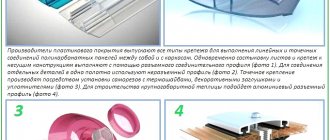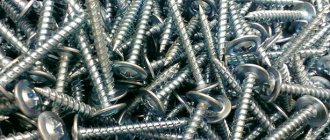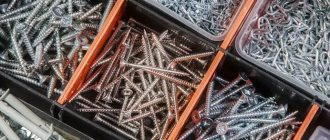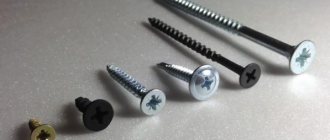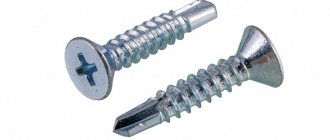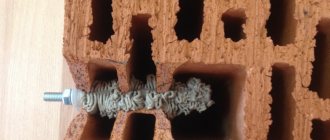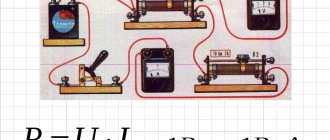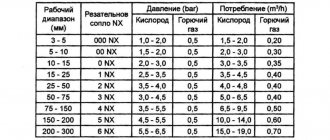When building a house yourself, you need to understand that there are no trifles in this matter. Even such a seemingly insignificant detail as self-tapping screws for metal tiles can have an impact on the overall service life of the coating. Therefore, the choice of hardware for the roof must be approached carefully. You need to choose roofing screws in such a way that these parts will last no less than the metal roofing itself. Saving on small things can lead to big expenses in the future.
When planning to begin independent construction, you should carefully consider the choice of building materials, even small ones such as self-tapping screws, which will be used to fasten sheets of metal tiles. When installing the roof, you need to remember that the entire coating will last as long as the shortest-lived material used for its installation can last.
If you do not want to change the roofing in a couple of years due to poor-quality screws, you should pay close attention to the choice of hardware. Let's consider how to choose fasteners and how to properly fasten metal tiles with self-tapping screws.
What screws are needed for metal tiles
It may seem that any type of self-tapping screws is suitable for laying and fastening profiled steel sheets. The fastener is screwed into the cavity of the profile wave with a recess into the wooden sheathing board, so the length of the self-tapping screw for metal tiles can be 25-35 mm. Formally, the metal sheet on the frame can be secured with any screw or self-tapping screw. You can even try using black carpentry or plumbing fasteners, which often happens when laying roofing on the roof of a summer house or shed.
In fact, the requirements for roofing screws for metal tiles are quite serious:
- The fastener must be equipped with a metal washer and a rubber gasket;
- At the working end of the self-tapping screw, a four-bladed drill is used to pierce the sheet and protective coating of the metal tile;
- The drill and threaded part are necessarily subjected to heat treatment, the tip is hardened;
- The surface of the screws is covered with zinc protection, and the head and upper part of the washer and rubber bands are painted in the color of the metal tile.
Important! Many experts pay attention to the quality of the carving. The top of the threaded profile must be sharp, then when screwing in the fastener, a counter groove is cut into the hole and into the thickness of the wood, firmly holding the rod inside the sheathing.
The quality of fasteners can be determined visually with a certain degree of accuracy. If you take a dozen randomly selected branded screws, inspect and compare, you will immediately notice the identical size of all elements. In addition, the color of the paint and the sheen of the zinc coating should not differ.
Choosing a quality material is just the beginning of the process; self-tapping screws of several sizes are used for installation, so you will need to calculate the screws for metal tiles by the number of pieces for each size group.
General information
One of the most popular and popular types of roofing in recent years is Monterrey metal tiles. This is exactly the material that is widely used for a wide range of work - from cottage construction to large-scale projects.
Monterrey metal tiles appeared in Russia in the 1990s. This was the name of the profile of Finnish metal tiles. It is this type of profile that is produced by manufacturers of Russian metal tiles. It is a multi-layer material made of galvanized steel.
The sheets imitate the shape of ceramic tiles, with which the roof reminds us of a historical, authentic roof. This material does not burn and is fire resistant. This material is available on the market in a wide range of textures and shades.
Details
Each layer performs its own function:
- The inner layer is a thin sheet of galvanized steel. It takes on all external load and protects against deformation.
- The sheet is coated on both sides with a galvanized layer, thanks to which the material is protected from corrosion.
- The entire surface of the profile is coated with a primer. It has a high degree of adhesion. This allows the paint to stay on the metal for a long time.
- A special coating is applied before the sheet is given a wave-cut shape. This layer qualitatively changes the roof covering. The surface becomes resistant to destruction. The tiles retain their color scheme. The material does not lose its properties at any time of the year.
- The inner layer is coated with a varnish composition, which provides additional protection.
Dimensions of self-tapping screws for metal tiles
Installation of metal tile roofing is not limited to just fixing the sheet on the roof sheathing. In addition to the main part of the work, there are two more important stages, such as sewing sheets of metal tiles together and installing additional parts - cornice and ridge strips, wind and gable corners, chimney pipes and valley assembly.
Therefore, the length of self-tapping screws for fastening metal tiles is also required for different purposes. At a minimum, three size categories are used:
- Self-tapping screws 28 mm, diameter 4.8 mm. This group can be used to fasten the thinnest and flattest types of metal tiles, but more often they are used for stitching sheets along the overlap line;
- Fasteners with a rod length of 35 mm. The most common version of the self-tapping screw is used for ordinary fixation of the sheet to the roof sheathing;
- Fastening material with a working part length of 50 mm. In certain types of roofing, additional elements require longer options with a rod of 70 mm.
Sometimes the question arises: why use fasteners with a length of 28 mm in order to connect two sheets, the thickness of which, taking into account the polymer coating, barely reaches 1 mm. The problem is in the design of the self-tapping screw and the installation technology.
Important! When laying metal tiles, the overlapped edges should not fit tightly to each other, so there is always a small compensation gap of a few millimeters between them.
When the rod is screwed in, the sharp edges cut thread grooves in the top and bottom sheets. It turns out something similar to two nuts screwed onto one bolt. It is in this position that a strong and at the same time flexible connection of the two sheets is ensured. The parts of the extensions are connected in a similar way. Naturally, correct and reliable fixation can only be achieved with high-quality fastening material.
Attaching the end strip
To secure the end strip, it is pulled with self-tapping screws to the highest points of the metal tile sheets every second wave.
Since these points are located at the same distance from the sheathing, the end strip will not be deformed when the screws are tightened until the gasket is properly compressed.
In addition, the end strip is attached to the gable board with self-tapping screws in increments of no more than 0.8 m. Since these screws will be clearly visible, they are screwed with self-tapping screws in accordance with the markings in order to maintain the rhythm.
How to choose the right self-tapping screws for metal roofing
Buying high-quality fasteners for assembling a metal tile roof is not as easy as it might seem to a novice roofer. The first and most basic problem is that the building materials market is overflowing with self-tapping screws of very different quality, most often not very high.
Therefore, when choosing fasteners, you need to pay attention to the main features:
- Geometry of drill, threaded rod and head;
- Availability of protective zinc coating;
- Paint quality;
- Condition of the washer and rubber;
- Metal quality.
It is clear that it is quite difficult to understand the quality of metal without special tools and experience. Therefore, you have to purchase a trial batch to make sure that the main quality criteria are met.
Advice! You shouldn’t really rely on the high price of self-tapping screws; shops often sell counterfeits of branded ones at fabulous prices.
If you focus on the brand, then it is best to take Gunnebo or Normand, made in Poland or Romania. They are used to fasten Finnish and Swedish models of metal tiles.
Self-tapping steel quality
The production of fasteners for metal tiles is based on stamping and rolling of steel wire. The softer the metal, the longer the punch and die last, so it is best to forge fasteners from low-carbon steel. In addition, the steel is subjected to heat treatment and hardening of the drill feathers. Hardened steel is much harder than low-carbon wire rod, which is available in abundance in wholesale warehouses.
To ensure the quality of the steel of a self-tapping screw, just hold it in pliers and rub it on the abrasive wheel of an electric sharpener. If the fasteners for metal tiles are made using technology, a sheaf of bright yellow sparks will appear. If the rod does not spark, then most likely it is a fake.
Sometimes craftsmen simply try to crush the threads on the rod with pliers; if the profile becomes wrinkled, then the quality of the metal is considered low.
Propeller geometry
Before purchasing, you need to check the accuracy of the rod dimensions. To do this, it is enough to inspect and compare the length of the thread and the drill bit of a dozen randomly selected self-tapping screws. If among the selected samples there were specimens with different cutting edge sizes or thread profile heights, then most likely this batch was obtained by mixing high-quality and low-grade screws.
Some roofers prefer to sort through and sort the purchased batch, separating high-quality and low-quality screws. The first ones go to the most critical areas of the metal tiles, the second ones fasten the overlaps and some of the additional elements. The method is not the best, since the quality of fasteners sharply decreases, and at the same time the consumption of self-tapping screws per 1 m2 of metal tiles increases.
Specimens in which the head is not perpendicular to the axis of the rod are definitely subject to rejection. With certain skill, such fasteners can still be wrapped in a sheet of metal tiles, but the sealing rubber band will be pressed unevenly, and the fastening point will leak.
Another problem that you have to face when choosing screws for metal tiles relates to the shape and size of the pen drill. The drill diameter should be 0.8 mm less than the midline, that is, 3.3 mm. If the diameter is 4.5-4.8 mm, then the self-tapping screw will not hold the metal tile on the roof and will simply come out of the sheathing under a little force.
Galvanizing and painting
When choosing fasteners, attention is usually paid to the strength of the paint and zinc layer. The latter should be shiny, firmly held on the thread and not rub off with your fingers or an elastic band.
The paint should remain without peeling or cracking even after installation on metal tiles. The quality of the paint layer must be so high that it can withstand the bending of the washer without cracking.
The last thing to check is the quality of the sealing gasket. The rubber band should be moderately hard and elastic in order to ensure the tightness of the fastening point on the metal tile and at the same time not be crushed when screwing the self-tapping screw into the steel sheet.
What is lathing and its installation
For proper installation of metal tiles, it is necessary to construct a sheathing, which is a wooden substrate in the form of a lattice or a continuous layer . The lathing performs several functions:
- Provides fastening of metal tiles
- Forms the necessary ventilation gap, preventing the under-roofing materials from getting wet from condensation.
- Creates an even plane, compensating for possible unevenness of the rafter system, which facilitates the normal installation of sheets and ensures maximum service life.
IMPORTANT!
The sheathing is installed on top of the waterproofing layer and attached to the rafters in rows corresponding to the pitch of the metal tile wave. Fastened with galvanized nails to prevent corrosion. The material for its manufacture is edged boards, most often 25 mm thick. The material must be dried, free from flaws, rotten areas, and must not be infected with mold or mildew.
How many self-tapping screws are needed for 1 m2 of metal roofing tiles?
In order to draw up a cost estimate, you will need to make at least approximate calculations for fasteners. The method for calculating the number of screws for metal tiles is as follows:
- The original area of the roofing tiles is taken;
- The number of sheets of metal tiles is determined;
- The number of screws for fixing to the sheathing and separately the number for stitching the overlap are calculated;
- The last is the number of long screws for additional roof parts.
First of all, you need to find out the number of screws per 1 m2 of metal tiles. For example, let's calculate the total amount of fasteners for a roof of 40 sheets of tiles for a gable roof.
A roof of 40 sheets means 20 inter-row joints. Each metal tile sheet will require 6 pieces, for a total of 120 pieces. For the ridge and cornice, for attaching the metal tiles, you will need 3 screws for each edge. It turns out 3x40=120 pieces. 4 pieces are placed on the end edges, it turns out 4x4 = 16 pieces. on each side, 56 pieces in total.
In order to sew the edges of one sheet along the overlap line, you will need 18 pieces of self-tapping screws. For 21 lines it turns out 21x18=378pcs. A similar number, but longer screws, will be required for the installation of additional metal tile parts. In total it turns out 120+120+56+378+378=1052 pcs. self-tapping screws
Installation
Before screwing the metal tiles, you need to check the geometry of the roofing structure again: the diagonals must be equal, the lines of the eaves and ridge are parallel to each other, like the sheathing boards, and located strictly horizontally. Defects are corrected at this stage, otherwise it will not be possible to lay the coating evenly.
Laying sequence
The laying pattern determines the size of the sheets:
- If their length allows you to cover the entire slope, first lay and align the first sheet along the cornice, making extensions from the side of the pediment and cornice. It is pre-attached with one self-tapping screw into the medium wave at the ridge. Then the second and third sheets are laid on it, fastened to each other at the crest of the wave and aligned together. After the final adjustment, the first two sheets are attached to the finishing sheet, and the next ones are adjusted.
- When the lengths are joined, installation begins from the bottom and 2 sheets are laid alternately, then the next 2 sheets are fastened to the first along the overlap ridge and the entire block is leveled before final fixation.
Schemes for laying metal tiles on pitched and hip roofs Source goldkryshi.ru
There are other methods of laying - in rows or in a checkerboard pattern. The main thing is that the edge is smooth, without steps, and parallel to the cornice. To do this, stretch a cord along the edge of the overhang as a guide and very carefully position the first sheet.
Note! When installing from the right edge, each subsequent sheet is laid overlapping on top of the previous one. If the installation is carried out on the left, on the contrary, the next sheets are placed under the already lying ones.
Installation from left to right and right to left becomes necessary when installing a hip roof, since in this case the metal tiles are attached to the sheathing from the center line of the triangle or trapezoid (see diagram above).
Peculiarities
The presence of a washer is the main distinguishing feature of roofing screws. The main task of the auxiliary element is to uniformly distribute the pressure of the head on the surface of the roofing, as well as completely seal the mounting hole. The functional features of the self-tapping washer for metal tiles influenced the fact that a rubber sealing ring appeared in this product.
Since the roof is exposed to precipitation, it is important that the sealing material is of sufficient quality. Based on this, an EPDM rubber O-ring is considered the best. This material perfectly tolerates temperature changes and other negative factors, while maintaining its basic characteristics for a long period of time.
The expected structural load affects the type of roofing screws. According to this criterion, fasteners are divided into two categories: metal-wood and metal-metal. This classification should not be neglected; self-tapping screws must be used strictly for their intended purpose.
There is no need to worry about the screw washers coming out on the surface of the roofing material.
Currently, on the construction market, it is quite easy to choose the required shade of screws that fully matches the color of the metal tile.
Stage 4. Protecting insulation from moisture
In order for thermal insulation to properly perform its functions, it must be dry. Getting wet by just 5% will halve the performance properties of the insulation.
To protect thermal insulation from moisture, vapor and waterproofing films and membranes will be required.
Vapor barrier
Protects thermal insulation from evaporation from the living space.
Laying sequence
The vapor barrier is installed horizontally on the roof slope, starting from the bottom.
Fixation
To fix the vapor barrier, it is attached to the bottom edge of the rafters using a staple gun.
Waterproofing
Provides protection of thermal insulation from condensation. Presented as:
- membranes (they are mounted without sagging, close to the thermal insulation);
- films (during installation, a sag of 20 mm is left).
Laying sequence
Waterproofing is mounted on the outside of the insulation, along the upper edge of the rafters.
Installation of waterproofing begins with the valley (if there is one) - the internal corner that is formed at the junction of the slopes. This roofing element requires careful sealing, since it often comes into contact with precipitation.
A roll of waterproofing is rolled out from the ridge to the eaves. The material should completely cover the valley area.
When the valley is waterproofed, they move on to the slopes. As in the case of vapor barrier, the roll is rolled out horizontally. First - along the cornice, then - higher (and so on - to the ridge).
Fixation
To fix the waterproofing sheets, you should install a counter-lattice made of wooden slats 50x50 or 32x50 mm.
Attention: do not forget about gluing the joints of the hydro- and vapor barrier sheets using double-sided connecting tape!
Criterias of choice
When purchasing self-tapping screws at a hardware store (to avoid purchasing low-quality goods), the parts must be tested according to several indicators.
- Test for the quality of protective coating. To do this, you need to strongly squeeze the press washer using pliers. A product that has a poor-quality coating will certainly crack. In most cases, electroplated zinc is used as a coating. This helps ensure maximum adhesion of materials.
- You should check the tightness of the gasket to the base and the quality of the rubber washer, which is located directly under the cap. The sealing ring ensures a tight fit of the self-tapping screw head to the metal tile sheet; the durability of the roofing depends on it. Poor quality gaskets deteriorate over time under the negative influence of the atmosphere and begin to leak moisture, which leads to corrosion of the coating.
- It is necessary to check the presence of appropriate markings on the cap. The absence of one may be an indicator of non-compliance with quality.
To guarantee the purchase of high-quality self-tapping screws, experts recommend products from European brands. Of course, these products are more expensive, but the high quality of the material, proven strength and reliability of the products (along with a long-term warranty) compensate for the costs incurred.
Roofing fasteners are made of high carbon steel and are necessarily tested before going on sale. Manufacturers of quality products guarantee a long period of operation, which is about 50 years.
During testing, self-tapping screws are subjected to severe deformations:
- about 20,000 bends at 5 degrees;
- 2000 bends at 10 degrees;
- 100 bends at 15 degrees.
The required dimensions of roofing screws, as well as the thread pitch, are determined based on the materials being fastened, their thickness and the desired penetration depth.

